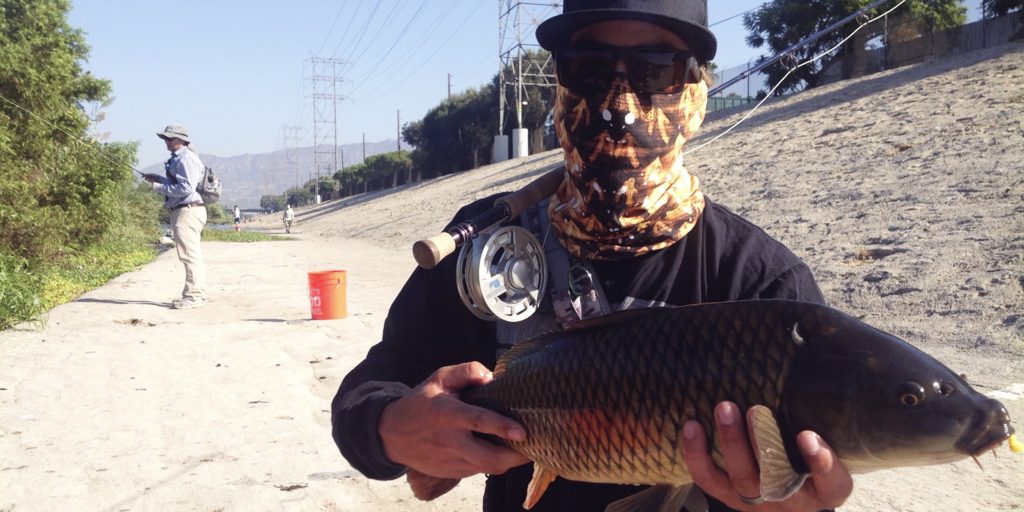“It is the magic of the Los Angeles River, a concrete corset that many know from Hollywood films: Drive, Transformers, Terminator 2: Judgment Day, it’s a long list that shows the concrete, but not the hidden seven miles or so nature has reclaimed.”
The Los Angeles River is the unlikely scene for some urban fly fishing, says Jim Burns
All rivers are initially hidden from the fly fishers who would caress fish from their bellies. Sure, you could hire a guide for several hundred dollars, hook up, and inhale a shot of Jack Daniels at the airport bar, thinking happily about what landed in your iPhone net, but then you would not really have known the river like a friend—more like a paid-for acquaintance.
As they say, some friends are hidden in plain sight. The Los Angeles River is one of these, not obscured by treacherous terrain, nor gurgling through unreachable canyons. Rather, the river was largely forgotten by the area’s populace until seasonal torrential rains land a few white-water rescued homeless on the evening news.
The river flows through seven US congressional districts, 10 city council districts, approximately 20 neighborhood councils and 12 community plan areas. On top of that with about 10 million people, LA is the United States’ second largest urban region, and Long Beach, down the road, is one of the world’s busiest ports. It also happens to be where the river exits to the Pacific Ocean.
Once discovered, almost any seasoned angler will tell you it takes several seasons to actually befriend a river. Best to experience at least spring and fall. Best to take time on the water, and errors in technique in stride.
Sometimes ugly, almost certainly forgotten, meandering through 51 miles of urban decay and suburban tract, I spent long weeks not knowing what the river needed from me. Carp, the game fish of choice, would scatter at my shadow in the intense southern California sun. A hard boot step was enough to make them plunge for cover.
Their behaviour was equally maddening: if one playfully jumped—gold, eureka, flash—instead of indicating you could hook up, it actually indicated the opposite. No dice.
If you were busy sight-casting, the slightest bit of line across a fish’s dorsal would send it, as well as its brothers, back into the weeds.
Fly fishing is about sinking into that unique sense of Adam’s ale, including the doubts that beset me on new water:
Is this fishy, or is farther along fishier? (Let’s find out.)
Did I leave my 5wt in the car, or at home? Should have brought whatever I don’t have. (Doesn’t matter.)
What’s everything eating? (Start with dries. Always begin on top.)
Do I still remember how to fish? (Good question.)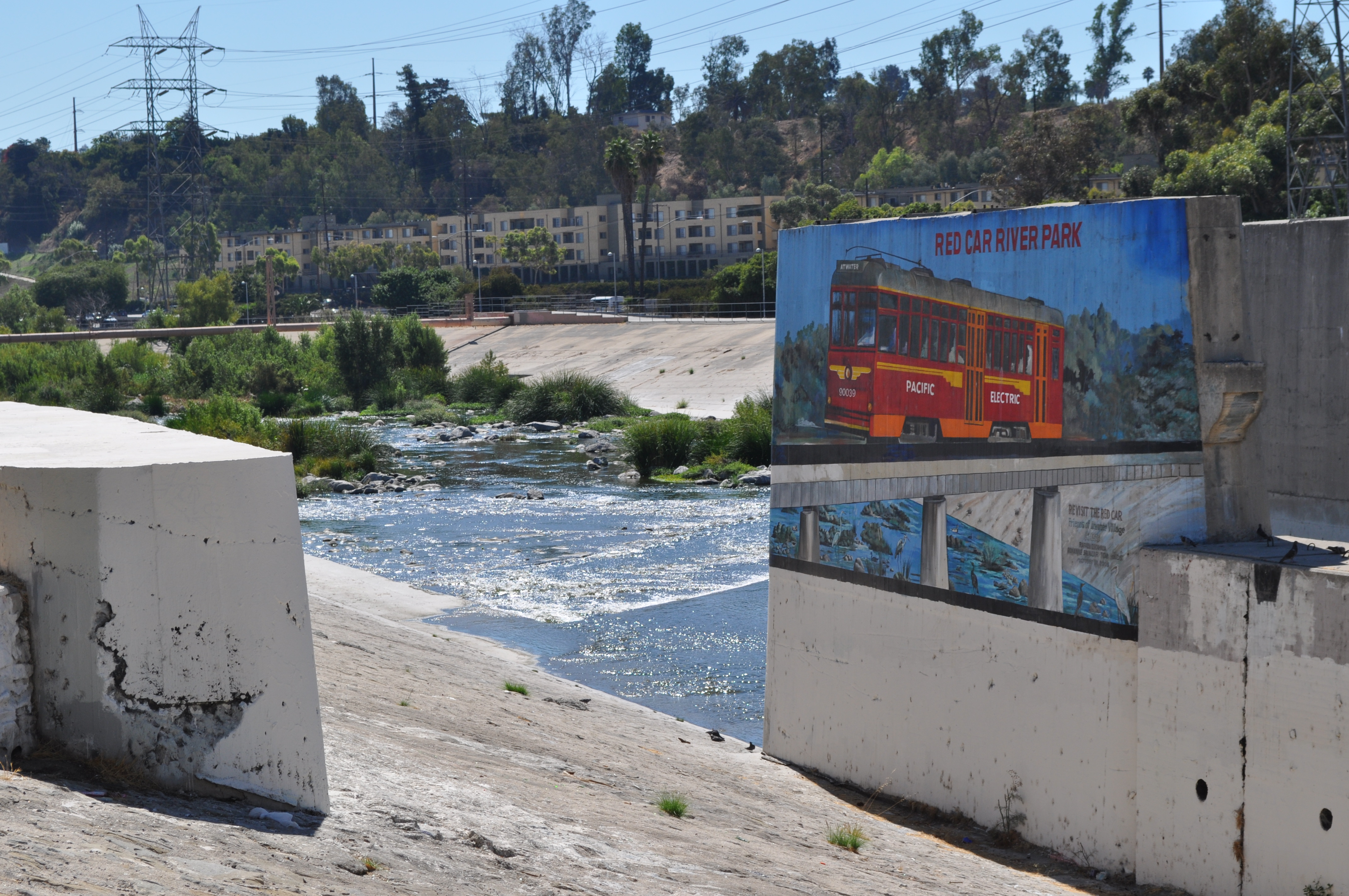
A masked sense of place won’t reveal its secrets to strangers, unless time is spent in watchful pursuit. And that’s the magic of any stream; it is the magic of the Los Angeles River, a concrete corset that many know from Hollywood films: Drive, Transformers, Terminator 2: Judgment Day, it’s a long list that shows the concrete, but not the hidden seven miles or so nature has reclaimed.
Urban fly fishing extends my list of doubts to include openness when talking to strangers (“Que haces?”); as well as creates a willingness to explore sketchy areas; fear of trolls under bridges; knowing good graffiti from bad; and growing comfortable with watery smells of sweet laundry detergent for the nose (fittingly Tide, a popular brand here in the US), while the Interstate 5 freeway’s constant traffic lulls the ears, much like a continuous mountain stream.
The water has held many items in the past: a Volkswagen, a skull, tennis shoes, southern California steelhead. Now, carp, bass, green sunfish, fewer plastic bags.
I’d lived in Los Angeles some 30 years before I ever tried to carp its river. I’d seen a video of a Vietnamese gentleman pulling a carp from the water, wide smile, traditional tackle. For moments, I dreamed myself into the video, only using a fly rod. Considerations: how do you catch a carp on the fly? In America, only recently have anglers viewed carp as a game fish, instead of a breeding trashing fish, which must be kept from the Great Lakes, for example, at any cost. Blow them up, electrocute them, whatever.
There are no native species left, except for an occasional arroyo Chub, a minnowlike rascal too small to catch. Dr Charles L Hogue caught the last recorded steelhead —26 inches of silver and fight—in 1940. In those days, the numbers of steelhead trout in the California region were estimated at 30,000. Today, those have plummeted and are at zero in this river. Southern California steelhead have been on the Endangered Species List since 1997. To be on that list, a species must be viewed by scientists as imminently in danger of becoming extinct.
So, after four years of exploration, countless wrong turns, lots of new friends, bonding with my grown son, the river became my “bestie.” I know her birds, her trees, her moods—even her enemies. I know the Los Angeles River as the coy, beautiful starlet, who got in with the wrong crowd. Yet one day soon, she will get a long overdue billion-dollar makeover, part of the government’s attempt to make good for sins of the past.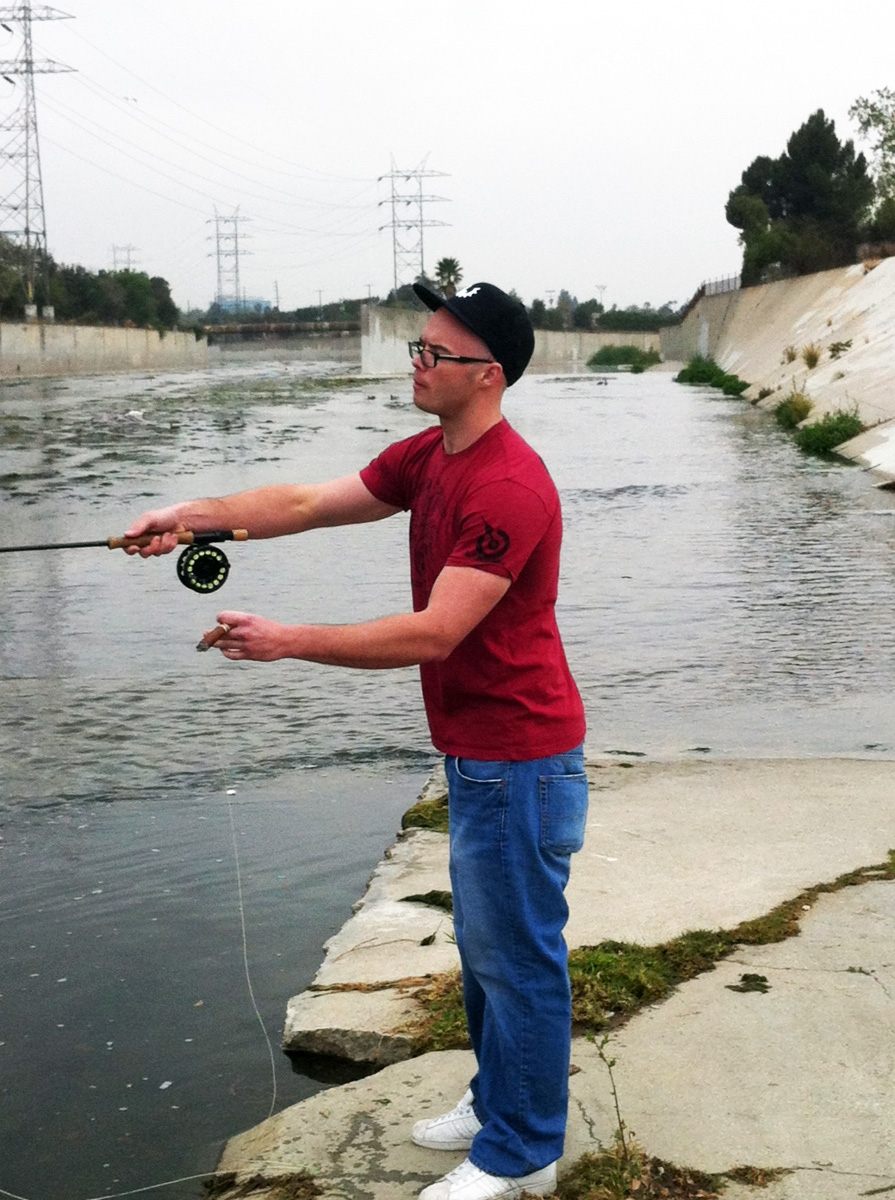
Will steelhead ever again run the river? We’ll see, crystal gazing. During these in-between years, we have carp—lots—waiting to frustrate the hell out of the casual angler, and exhilarate those who steadily seek to catch them.
Exactly how carp—both common and mirror—came to make the river their home is a mystery. Come the spring spawn, dozens and dozens of carp run up the river, sometimes in as little as an inch of water. Groups of smaller males chase one large female from pool to pool, under freeway bridges, across gigantic concrete slabs. Locals take pictures, some point, dog walkers want to make sure you see what’s happening, most can’t quite believe the miracle—big, golden fish splashing in a forgotten river.
You can actually pick them up out of the water, it’s that shallow in places. Most carp average several pounds to about 10 pounds. One fishing friend theorized that they were headed for Lake Balboa at the river’s top in the San Fernando Valley, but that’s never been proven. If it were true, however, there’s a deep parallel between the carp spawn and that of the mighty steelhead, who would wait until rushing winter storm water to clear the sandy berms from the ocean, then push onward toward its mountain spawning grounds, some 50 miles away.
The land’s slope, from mountain to ocean in these 50 miles, is equivalent to that of the Mississippi River, from its origin to New Orleans, some 2,300 miles away.
That oddity of topography landed the river in its concrete encasing in the first place, with flood water clocked at over 50 miles per hour. After the disastrous flood of 1938 in which more than 100 died, the city asked the US Army Corps of Engineers to make the river safe. All the engineering, digging and cementing took several decades, but in that year, 10,000 workers and 3 million barrels of concrete applied by hand began the encasement. Now that we see through an ecological rather than an Industrial Revolution lens, at least some of the concrete is slated to come out.
The Army Corps awaits approval from Congress to begin a $1 billion makeover of some 14 miles of river, in its midsection that already contains copious trees, more than 100 species of birds and, of course, fish. The Corps’ mission for ecosystem restoration is to turn the clock back to historic conditions, before human involvement, which is difficult, to put it euphemistically. Part of its research came from the nearby Huntington Library, built on the estate of the millionaire owner of the Southern Pacific Railroad. Yes, the same dude who employed the Chinese workers we’ll get to in a moment.
Engineers used historic linen maps from 1896 that were very detailed, and showed the course of the river, where it meandered, as well as some of the habitats in place at that time. Farmers had already planted crops adjacent to the river, and there was the seedling of human settlement downtown, which would eventually grow to what we know today.
Another mystery is exactly how all of these non-native fish got into the river in the first place. The popular theory goes that when Chinese laborers came from Canton to build the Southern Pacific Railroad they needed eats akin to what they enjoyed in their homeland. Industrious purveyors farm raised carp in tanks, so the story goes, in the same way tilapia are raised for consumption today. When the river flooded, which it does periodically, the carp got swept into the river.
The story seems incredible to me, in the same vein as the disinformation campaigns that the UFO contingent claim the government used to discredit the Roswell, New Mexico, sights from the 1950s: sprinkle smidges of the truth among a vast conspiracy of falsehoods.
Of course, we do know that the river is a convenient place to drop former aquarium dwellers that have overgrown their indoor habitats. An angler recently caught and documented a pacu, the piranha’s cousin with flat teeth and a taste for human testes, as documented in a story about two unlucky villagers in New Guinea. Even though a catch-and-release fly fisher, he opted not to put that one back.
Another story, probably apocryphal, is that the city planted tilapia in the river to combat mosquitoes in the 1970s. What we need is a dedicated historian to dig into the dusty archives and tell us exactly how these various nonnative species came to call the river their home, for part of the Corps’ plan may include eradicating all nonnatives and restoring natives, which would include trout, at the very least. To do this would mean lowering the water temperature, providing natural shade and protection from flooding, and a host of other habitat designs.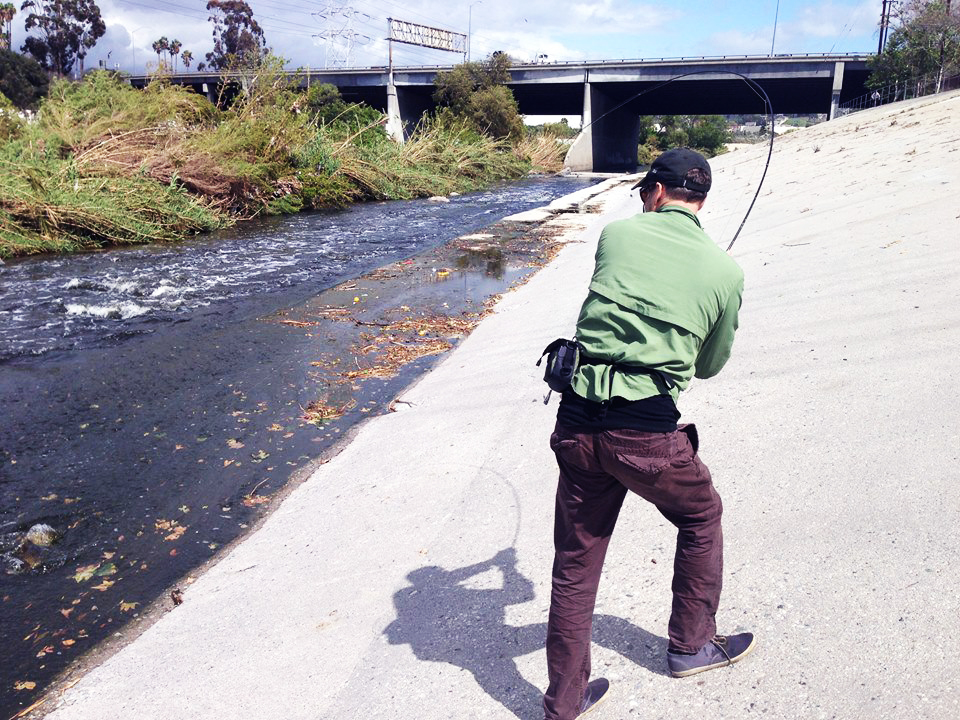
But for today’s pre-billion-dollar boots on the ground, catching a carp is as delicious a feat as I’ve ever experienced. From my online diary:
“AM off to the LA River with my 5wt, armed with a fine new line, new leader and new reel. Throw in, hook up within five minutes (rare) and—BAM—knot fails after three sharp tugs.
“Blame the new 5X leader, curse the gods, curse the river weeds, curse anything but the fish. From the size of the pull, think the better of a 5X leader and get on down to a 2X. Toss in, wait a bit—BAM—same result, including failed knot.
“Curse Orvis, maker of the slippery leader, curse limited knot skills, curse Lou Ferrigno, for no reason. Look up at monochrome sky and ask ‘why?’
“Sit on rip rap*. Retie. Walk upstream, toss in, hook up—BAM—fish on. Big fish on.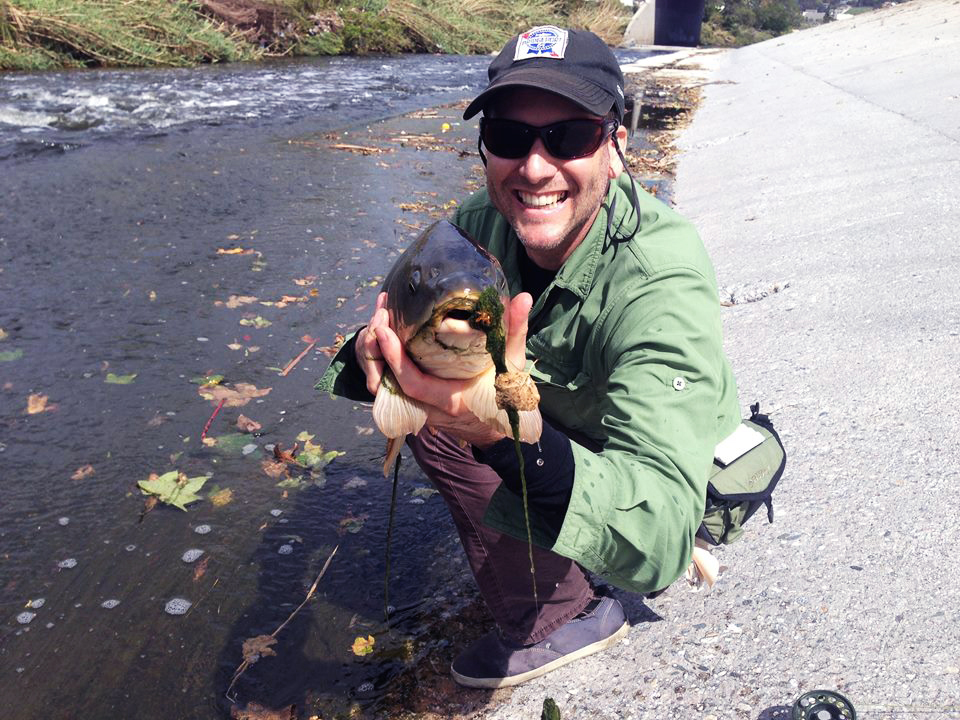
“Mental notes intrude on sweaty, running experience… Play him on the reel. Slow down the narrow spool with palm, getting hot, ouch. Turn head, tire him out, another run, fingers, ya—oh, man that smarts, more mental notes. What’s with the mental notes? Blame golf psychology book, Golf Is Not a Game of Perfect, that is current read.
“Walk back, walk back slowly. Runs again, remember that knot fail! Ease it up, running, slow him down.
“In close now. Gold shine, liquid undulating gold. We see eye to eye. Back up, back up, and… he’s ashore.
“Heart pumping, mental note, take the iPic. Fumble in pocket. Curse the white-hot September light, so bright I can’t really image the picture. A Mexican guy on a bike on the bike path, says ‘take a picture,’ as both a question and a statement. I think to myself, ‘but I am taking a picture,’ and then realize maybe he wants to scale down the rip rap* and take a snap of me and this California gold rush.
“Elation. Snap. Fish back in water. Heart beats hard; left hand hurts; praise Orvis, praise my limited knot-tying ability, praise the very moment, alive, so very alive.
“I right myself, put back in, same fly, and quickly get a different kind of tug, bass tug. Oh, yes, this is so easy, haha, nothing to it, and will it ever happen to me again? Snag an LA river deuce, same day, same fly. Hallelujah.”
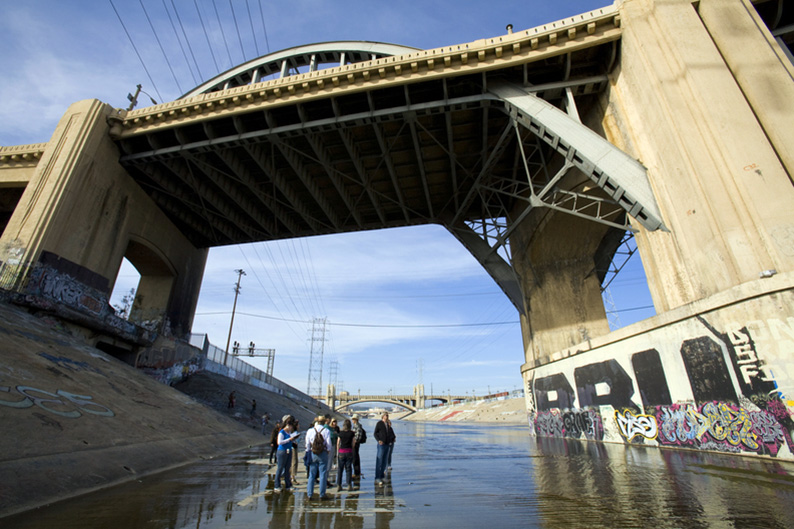
Photography courtesy of LAriverflyfishing.com
* Rip rap is the concrete siding that goes down to the water.
In some places, it’s quite steep

